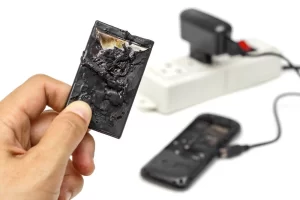
If you’ve ever wondered how and why lithium-ion batteries in devices like smartphones and laptops combust, iFixit is here with an explosive video and some accompanying wisdom on safe battery-handling.
Tech writer team lead Arthur Shi and teardown techie Shahram Mokhtari from the DIY electronics repair site got together to stab some iPhones and laptop batteries, and even shot a giant battery with a nail gun – all for science, of course.
The pair’s objective wasn’t only to show how awesome shots of batteries exploding in slow motion looks, but also to demonstrate what they said is a key part of staying safe when working around lithium-ion polymer (li-po) batteries: their charge level.
“The batteries in our electronics tend to grab headlines when they go awry, but the truth is those are extreme edge cases,” Mokhtari said.
Why li-po batteries go bust
If you’re not familiar with the makeup of a lithium-polymer battery, Shi’s explanation in the video breaks it down pretty plainly. Think of it like a fruit rollup, packaged tightly in its cellophane plastic wrapper to keep the layers from sticking together.
A single li-po cell is like a wrapped fruit roll that’s filled with an electrolyte slurry, and a thin separator sits between the positive cathode and negative anode to prevent them from touching and causing a short circuit.
The typical li-po fire is caused when a battery is punctured or damaged in such a way that the separator is damaged, causing a short circuit. With enough energy contained in the battery, the flammable vapors caused by the decomposition of battery electrolytes can be heated to the point they explode, leading to thermal runaway that can burn for hours, depending on the size of the battery and damage.
As li-po batteries age, the chemical reaction that supplies power can degrade, leading to the creation of gasses that cause swelling. While swollen batteries are hazardous, the iFixit team said that even when swollen, a battery won’t explode if discharged.
To demonstrate how batteries at different charge levels explode or don’t, Shi and Mokhtari stabbed an iPhone 12 Pro Max with a fully charged battery and one discharged to 25 percent. When punctured with a metal tool, the results were radically different.
The battery charged to 25 percent smoked and emitted some sparks, but never caught fire because there wasn’t enough energy in the battery to lead to thermal runaway. The full one, on the other hand, was more than happy to go up in flames.
Stopping thermal runaway
Techies working on lithium-ion devices should take some basic precautions, iFixit said, like the aforementioned discharging of batteries to 25 percent before beginning repairs. Batteries should also be the first thing disconnected and last reconnected.
It’s also ideal to use plastic tools whenever possible. Shi and Mokhtari demonstrated stabbing an iPhone battery with a plastic spudger, which damaged the battery but didn’t cause any smoke or damage as the plastic reduces the chance for a puncture to cause a spark.
One final word of warning from the pair was to do with the handling of large li-po batteries, like those in laptops and larger hardware. Even when discharged to 25 percent, such batteries can still contain enough potential energy to cause combustion. For safety, discharge larger batteries completely, but recharge them as soon as repairs are complete to prevent damage.
And it goes without saying, but don’t shoot a battery with a nail gun, regardless of its size.
